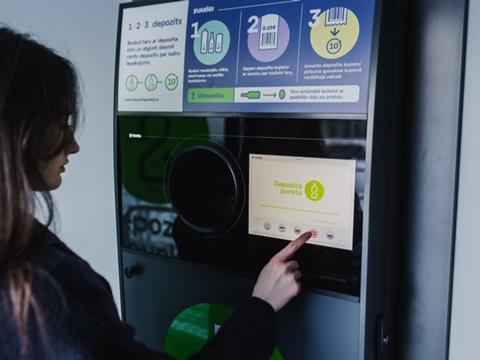
Depozīta Iepakojuma Operators (DIO) reports that its Latvian deposit return system has achieved an 80% return rate upon its two-year anniversary – surpassing the 77% target set for plastic bottles by 2025 in the EU Single-Use Plastics Directive.
Latvia’s deposit return system (DRS) was launched on 1st February 2022. Since then, the country’s collection rate for PET containers has apparently increased from 45% before the system to 83% two years later.
For refillable drink containers, the collection rate is said to have risen from 50% to 90%.
The DRS has exceeded the Directive’s goal to separately collect 77% of plastic drinks containers by 2025 and plans to meet the legislation’s target to collect 90% by 2029.
Furthermore, independent and litter monitoring organizations record a 61% reduction in plastic containers littering the coastline of the Baltic Sea between 2021 and 2023 – as well as a 49% reduction among all DRS containers, with the ‘Save Our Sea’ campaign finding no containers bearing a deposit symbol in a clean-up of the Gauja River.
A survey suggests that 54% of consumers believe the Latvian environment to be cleaner since the DRS came into force.
The system charges a container deposit of €0.10 and uses a return-to-retail model, in which consumers can regain their deposit by returning empty cans and bottles for recycling. Its collection infrastructure is provided by TOMRA Collection.
Upon its launch, it accepted PET, aluminium, and steel containers, alongside glass for carbonated and non-carbonated non-alcohol drinks, beer and other fermented products with an alcohol content of up to 6%.
Since 1st January 2023, it has also welcomed containers for syrups, cocktails with up to 15% alcohol content, and all alcoholic drinks in PET and metal containers.
TOMRA aspires to provide Latvian citizens with a ‘safe and modern’ DRS that offers convenience for both consumers and retailers, normalizes the process of returning container packaging, and achieves a high return rate.
DIO reports that 69% of DRS participants had recommended the system to other consumers by March 2023, and 73% by October 2023. In another study, 80% of Latvia’s population were said to use the deposit system at least once a month – a 9% increase from the previous year – as were 94% of Latvian households.
Consumers can now opt to donate their deposit refund to charity directly from TOMRA’s reverse vending machine, with €357,000 thought to have been donated in the space of a year.
“TOMRA globally has first-hand experience with every part of the DRS value chain, from material pick-up and PET processing, to data management,” says Mats Toots, TOMRA Collection aountry manager for Latvia. “We’ve played a key role in large-scale DRS infrastructure roll-outs across the globe, so we felt very comfortable with this project.
“We were able to guide retailers and other stakeholders through the process with efficiency, speed and confidence.”
Miks Sturitis, chairman at DIO, adds: “An average return rate of 80% over two years is a commendable achievement. We are highly motivated to continue improving the system, making it even more convenient and accessible for society.
“This includes upgrading collection capabilities in high-demand locations and further educating our younger generation and societal groups that are not yet fully participating in the return process. Our goal is to achieve a 90% collection and recycling rate by the end of 2025.”
Research is also being conducted around the new DRS in the Republic of Ireland. Every Can Counts states that nearly a third (29%) of consumers are not confident in their knowledge of the new scheme – yet nearly seven in ten (69%) believe it will encourage them to recycle more.
Also, Sensoneo plans to power a DRS for single-use beverage containers in Austria from January 2025 and achieve a 90% rate by 2027.
If you liked this article, you might also enjoy:
The Lidl approach to packaging sustainability
How did Brazil achieve its 100% aluminium can recycling rate – and can it be replicated in the EU?
Experts have their say on the EU’s Packaging and Packaging Waste Directive revisions
A deep dive into the most important packaging sustainability trends and solutions




















No comments yet